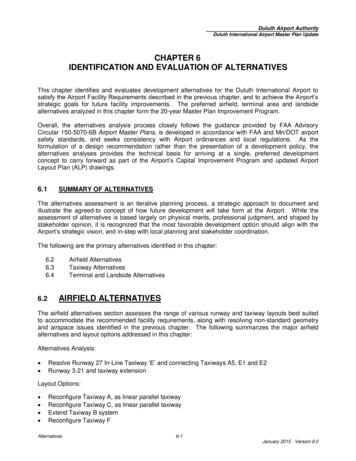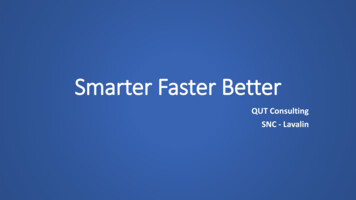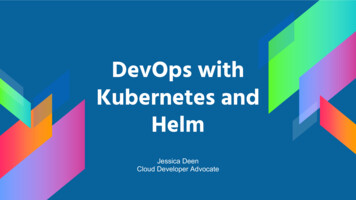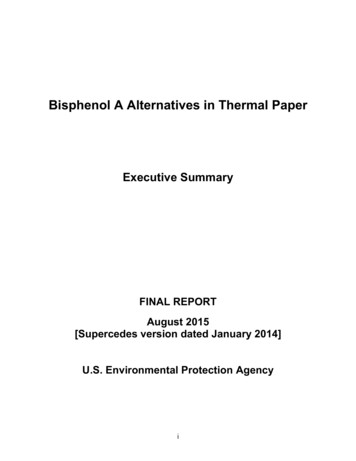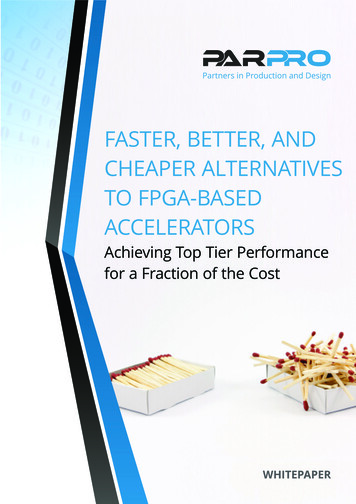
Transcription
FASTER, BETTER, ANDCHEAPER ALTERNATIVESTO FPGA-BASEDACCELERATORSAchieving Top Tier Performancefor a Fraction of the CostWHITEPAPER
Table of ContentsIntroduction3Faster Time to Market5A Better and More Flexible Platform7A More Cost-effective Approach9Conclusion10About PARPRO11Whitepaper - Alternatives to FPGA-based Accelerators02
IntroductionEven as the number of cores in general-purpose CPUs continuesto climb, many difficulties remain in building systems that arecapable of handling large volumes of network data. This is due toseveral factors, including the ever-increasing rate of networktraffic and some fundamental limitations in general-purposecomputing architectures. System designers are constantlyseeking ways to expand their system capacity beyond suchlimitations.FPGA-based “accelerator” cards are commonly used to expand systemcapabilities beyond those of a general-purpose CPU. Such cards usually containmultiple network interfaces, a high-end FPGA device, and some number oflicensed IP cores inside the FPGA for specific tasks such as pattern matching,cryptography, compression, or even storage-related mathematical operations.Connectivity between the general-purpose CPU and the accelerator card isgenerally done via a multi-lane PCIe connection between the two subsystemsWhile system design such as this offers significant increases in systemperformance, this approach has several drawbacks, most notably the longdevelopment cycles of FPGA code, limits on certain types of resources in theFPGA, and the expense of the FPGA itself and the licensed IP cores containedwithin. In addition, the task of the system designer now includes the addedresponsibility of partitioning the workload in an efficient and effective manner toachieve maximum throughput and minimal latency in the data path. There is,however, an alternative approach.Whitepaper - Alternatives to FPGA-based Accelerators03
An NPU-based architecture offers many of the development benefits oftraditional CPU platforms while also offering many of the performance benefitsof the FPGA approach. And with Linux a prevalent operating system on bothCPUs and NPUs, the task of migrating workload from the CPU to a more flexibleNPU offers dramatically easier development and test cycles, which in turnaccelerates your time-to-market.“Typical architectures of FPGA and NPU based accelerator cards.Whereas FPGA architectures have complex workload partitions,the NPU approach is more flexible for a faster development cycle.”Whitepaper - Alternatives to FPGA-based Accelerators04
Faster Time to MarketFor those applications which are very well suited to processing inan FPGA, nobody will argue that a general-purpose CPU canperform as fast. The example of signal processing applications,which is much more suited to FPGAs or DSPs than almostanything else, comes immediately to mind. However, there aremany applications which are deployed onto FPGA-basedplatforms that are only moderately-well suited to that approach.For example, financial industry applications will use FPGAs as away to get lower latency than an x86 processor, even thoughmanaging a large dataset like an Order Book isn't necessarily wellsuited to a platform which does not have cache or has limitedmemory bandwidth. The FPGA has become a go-to solution, butat the significant cost of development time.The task of developing FPGA code is a very different one from developing codefor a CPU or NPU. While there are many common elements, FPGAs present anentirely new realm of issues which need to be accounted for in the design andtested for during the quality assurance phase of any project. Aside from obviousconcerns such as timing closure and limited quantities of certain types ofresources (registers, clocks, etc.), more broad issues such as the difficulty ofperforming upgrades in the field and proper design of the data path pipelinemean that the development cycle for FPGAs are very long. In the modern era ofrapid release cycles, a fast time to market is a critical aspect of any project andthe FPGA approach doesn't easily support that.Whitepaper - Alternatives to FPGA-based Accelerators05
Meanwhile, the benefits of the NPU approach include programming in high-levellanguages (C or C , most commonly), the availability of both source-code andassembly-code debuggers, and a large collection of pre-existing libraries forroutine tasks (i.e. sending and receiving packets) – all of which are familiar toexisting application developers. Partitioning application workload often comesdown to separating various application functions into separate programs, andthen simply re-compiling those application components on the NPU withminimal changes – leading to a much faster development timeline.The PARPRO O3E-110 Accelerator Cardis a high-performance networkprocessor PCI Express card designedfor use in PCI Express compliant systemsWhitepaper - Alternatives to FPGA-based Accelerators06
A Better and MoreFlexible PlatformThere is no dispute that, in terms of combinatorial logic, nothingcan beat the performance of an FPGA. The FPGA code directlytranslates to gates and registers with specific timing constraints toguarantee that the output is correct. But, that fine-grained levelof control in the FPGA code also reveals a weakness – morecomplex applications are exponentially more difficult. Often,common IP blocks such as PCIe or DDR3 come in pre-packagedblocks which are licensed from 3rd party vendors, which limits theflexibility of such components. Making a small change in a FPGAdesign can have massive impacts on timing constraints andresource allocations throughout the design.At the core of an NPU, however, is a RISC microprocessor – often 64-bits withdozens of cores and running at speeds approaching 2.0GHz. Like its x86 CPUcounterpart, it is surrounded with flexible I/O blocks that use standardizedinterfaces (PCIe, XFI, SGMII, etc.) and relatively large amounts of memory (insome cases as much as 256GB of DRAM). With that microprocessor comes thecapability to easily add or change tasks and data path processing without fear ofrunning out of a constrained resource like FPGA registers. Different firmwaremodules can be loaded and unloaded to provide different behaviors on-the-fly,and software upgrade is trivial (especially when compared to re-programming aflash device for an FPGA). Major interfaces, such as DRAM and PCIe, are built-into hard logic gates in the ASIC and are ready-to-use in your application.Whitepaper - Alternatives to FPGA-based Accelerators07
The flexibility of a programmable microprocessor would normally come with thepenalty of lower performance, but NPU vendors address that problem byproviding “offload engine” blocks within the NPU. Much like the way the CPUoffloads tasks to the accelerator card, the NPU microprocessor can offload tasksto these offload blocks for increased performance. Common block includecompression and decompression, encryption and decryption, key generation,pattern matching / search, and sometimes even RAID calculations for storageapplications. This combination of small blocks of dedicated logic and the moregenerally programmable microprocessor give tremendous flexibility to theaccelerator while retaining much of the performance gains that an FPGA-baseddesign provides.“The task of developing FPGA code is a very different one from developingcode for a CPU or NPU. While there are many common elements, FPGAspresent an entirely new realm of issues which need to be accounted for inthe design and tested for during the quality assurance phase of any project.”Whitepaper - Alternatives to FPGA-based Accelerators08
A More Cost-effectiveApproachThe price of electronic components is a constantly shiftinglandscape, but even within that FPGAs are notoriously difficult toprice. Pricing is often done on a per-engagement basis, with listprices that are so high as to be downright obscene only to havediscounts of up to 90% applied, depending on the specificprogram. Furthermore, developers often initially plan to use onespeed grade of FPGA, only to discover mid-way through thedevelopment effort that a faster speed grade will be required tomeet all timing constraints, at a significantly higher price.Then, of course, there is the question of purchased IP for the FPGA. Such blocksare often licensed with a significant up-front cost and a per-unit charge as well,impacting both the development budget and the product's per-unit cost.By comparison, NPU pricing is significantly more reasonable. While NPUs areknown to be “more expensive”, that is in comparison to x86 platforms whichhave significantly higher global production volumes, and thus better economiesof scale. By comparison to FPGAs, however, NPUs are the same price orcheaper – low-end NPUs can be as little as 15 with high-end parts under 1k,significantly less than high-end FPGA devices.Whitepaper - Alternatives to FPGA-based Accelerators09
ConclusionFundamentally, the concept of an offload accelerator is a goodone. But while the FPGA approach may be a common choice foran accelerator platform, an NPU should be considered. Manyapplications, especially those which deal directly with networktraffic, can be efficiently offloaded into NPU-based architectureswith a design which gives a faster time to market, a better andmore flexible solution, and does so at a lower price point than theFPGA alternative.“This combination of small blocks of dedicated logic and the more generallyprogrammable microprocessor give tremendous flexibility to the acceleratorwhile retaining much of the performance gains that an FPGA-based designprovides.”Whitepaper - Alternatives to FPGA-based Accelerators10
About PARPROPARPRO is a full service design and manufacturing company withan emphasis on ODM solutions. We offer a comprehensiveengineering-rich hardware solution with low-to-high volumemanufacturing and integration/test capabilities, and prideourselves on delivering simple to complex solutions making ourmanufacturing offerings competitive at virtually any volume andwith any sourcing strategy.We serve customers in the aerospace, gaming, telecommunications andindustrial markets providing time savings and cost optimization by minimizingmargin stacks throughout the value chain.PARPRO Embedded Systems, a business unit of PARPRO, provides next-genmulti-core and switching platforms. We team with our customers andtechnology partners to deliver innovative embedded computer hardware inapplication-specific platforms. Whether you need a custom appliance, PCIExpress, AMC, or ATCA, PARPRO can help you respond quickly to businessopportunities.AuthorMatthew DharmMatthew Dharm is the Chief Technology Officer of PARPRO's EmbeddedSystems group. Matthew has worked in the embedded computer industrysince 1998 and is an experience software and systems designer with specialemphasis on single board computers across multiple platforms andarchitectures and high-performance mixed-solutions. His career has touchedon such diverse markets as mobile communications, defense, medical,datacenter, and many others. Matthew graduated from Harvey Mudd Collegewith a B.S with Distinction and was a founder of JumpGen Systems, whichwas later acquired by PARPRO to become their Embedded Systems group.CTO, PARPROEmbedded SystemsWhitepaper - Alternatives to FPGA-based Accelerators11
N. AMERICA HEADQUARTERSNEVADA - USPARPRO Embedded Systems (CA)PARPRO Nevada2772 Gateway Road, #1027390 Eastgate Road, #160Carlsbad, CA 92009Henderson, NV 89011Tel: 1 (760) 931.7800Tel: 1 (702) 331.2700MEXICOTAIWANPARPRO MexicoPARPRO TAIWANPeriférico Sur No. 1 Col. Obrera67-1, Dongyuan RoadTijuana, Baja California MéxicoChungli Industrial Park, TaoyuanC.P. 22180Taiwan 32063Tel: 1 (664) 637.5602Tel: 886 3 452.5535For General inquires, please contact1-844-PARPRO-1 or 1 (760) 931-7800Email: sales@parpro.comCopyright 2015 PARPRO All rights reserved.
Whitepaper - Alternatives to FPGA-based Accelerators 10 Fundamentally, the concept of an offload accelerator is a good one. But while the FPGA approach may be a common choice for an accelerator platform, an NPU should be considered. Many . 11/25/2015 1:29:48 PM .
